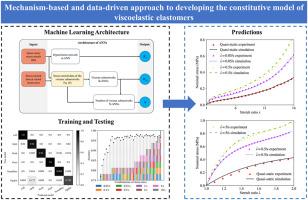基于机理和数据驱动的粘弹性弹性体构成模型开发方法
IF 3.4
3区 材料科学
Q2 MATERIALS SCIENCE, MULTIDISCIPLINARY
引用次数: 0
摘要
几十年来,粘弹性弹性体的构成模型一直是一个活跃的领域。在这项工作中,我们开发了一种基于机理和数据驱动的方法,用于开发大变形条件下粘弹性弹性体的构成模型。基于有限变形粘弹性理论,我们在设计机器学习架构时利用了应变能量密度函数的特点,从而可以快速生成合格的人工数据来训练人工神经网络(ANN)。根据弹性体的典型微结构,我们建立了三组人工神经网络来确定超弹性和粘性聚合物网络的应变能密度函数,并通过我们自己的实验数据和文献数据对其进行了进一步测试。机器学习架构还允许灵活扩展 ANN 数据库,以考虑新开发的弹性体。所开发的材料构成模型可自动满足热力学定律,并可在有限元分析中轻松实现更复杂的结构和加载条件。所开发的数值和实验框架为粘弹性弹性体的构成模型提供了一个有效的范例。本文章由计算机程序翻译,如有差异,请以英文原文为准。

Mechanism-based and data-driven approach to developing the constitutive model of viscoelastic elastomers
Constitutive modeling of viscoelastic elastomers has been an active field for decades. In this work, we develop a mechanism-based and data-driven method to develop constitutive models of viscoelastic elastomers under large deformation. Based on the theory of finite deformation viscoelasticity, the feature of strain energy density function is utilized when we design the machine learning architecture, which allows for fast generation of qualified artificial data to train artificial neural networks (ANNs). According to the typical microstructures of elastomers, three groups of ANNs are established to determine the strain energy density functions of the hyperelastic and viscous polymer networks, which are further tested by experimental data of our own and those in the literature. The machine learning architecture also allows for flexible expansion of the ANN database to consider newly-developed elastomers. The developed constitutive model of the material automatically satisfies the laws of thermodynamics and can be easily implemented in finite element analysis for more complex structures and loading conditions. The developed numerical and experimental framework provides an efficient paradigm for constitutive modeling of viscoelastic elastomers.
求助全文
通过发布文献求助,成功后即可免费获取论文全文。
去求助
来源期刊

Mechanics of Materials
工程技术-材料科学:综合
CiteScore
7.60
自引率
5.10%
发文量
243
审稿时长
46 days
期刊介绍:
Mechanics of Materials is a forum for original scientific research on the flow, fracture, and general constitutive behavior of geophysical, geotechnical and technological materials, with balanced coverage of advanced technological and natural materials, with balanced coverage of theoretical, experimental, and field investigations. Of special concern are macroscopic predictions based on microscopic models, identification of microscopic structures from limited overall macroscopic data, experimental and field results that lead to fundamental understanding of the behavior of materials, and coordinated experimental and analytical investigations that culminate in theories with predictive quality.
 求助内容:
求助内容: 应助结果提醒方式:
应助结果提醒方式:


